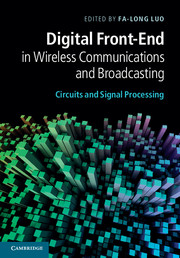Book contents
- Frontmatter
- Contents
- Contributors
- Preface
- Part I Introduction to digital front-end
- Part II DPD and CFR
- Part III DUC, DDC, ADC, DAC, and NCO
- Part IV Digital calibration, imbalance compensation, and error corrections
- Part V Circuits and system integration in digital front-end
- 20 Integration and interface of digital front-end with analog front-end
- 21 Circuits and systems for digital front-ends to support multiple wireless standards
- 22 Programming models and implementation platforms for software defined radio configuration
- 23 Programmable discrete-time integrated receiver front-ends
- 24 Multi-port front-end and transceivers for V-band multi-gigabit/s communication systems
- 25 Cross-layer design and digital front-end for cognitive wireless link
- Index
- References
25 - Cross-layer design and digital front-end for cognitive wireless link
from Part V - Circuits and system integration in digital front-end
Published online by Cambridge University Press: 07 October 2011
- Frontmatter
- Contents
- Contributors
- Preface
- Part I Introduction to digital front-end
- Part II DPD and CFR
- Part III DUC, DDC, ADC, DAC, and NCO
- Part IV Digital calibration, imbalance compensation, and error corrections
- Part V Circuits and system integration in digital front-end
- 20 Integration and interface of digital front-end with analog front-end
- 21 Circuits and systems for digital front-ends to support multiple wireless standards
- 22 Programming models and implementation platforms for software defined radio configuration
- 23 Programmable discrete-time integrated receiver front-ends
- 24 Multi-port front-end and transceivers for V-band multi-gigabit/s communication systems
- 25 Cross-layer design and digital front-end for cognitive wireless link
- Index
- References
Summary
Introduction to flexible cognitive wireless link
This chapter presents some algorithms and technology that are used in the Physical (PHY) layer entity of a flexible or cognitive radio. In the context of this chapter, cognitive radio refers to a wireless air interface that implements the cognitive cycle introduced by Mitola in his Ph.D. thesis [20]. This cycle is illustrated on Figure 25.1 and is composed of four main steps: the “Sense” acquires relevant information from the radio environment, the “Analyse” and “Decide” steps represent all that implies some intelligence, “Analyse” for interpreting the observation of the “Sense” step, “Decide” for learning, planning, and decision making, and finally the “Act” step reconfigures the transceiver’s communication parameters, with the transceivers designed with software defined radio (SDR) principles in order to be as flexible as possible.
Mitola underlines the strong need for defining a novel wireless air interface (i.e., Media Access Control MAC and PHY layers) based on cognitive radio. This air interface should support the new functionalities described in Figure 25.1; the MAC layer (or the cognitive manager) operating the “Analyse” and “Decide” steps and the PHY layer operating the “Sense” and “Act” steps.
- Type
- Chapter
- Information
- Digital Front-End in Wireless Communications and BroadcastingCircuits and Signal Processing, pp. 733 - 757Publisher: Cambridge University PressPrint publication year: 2011



